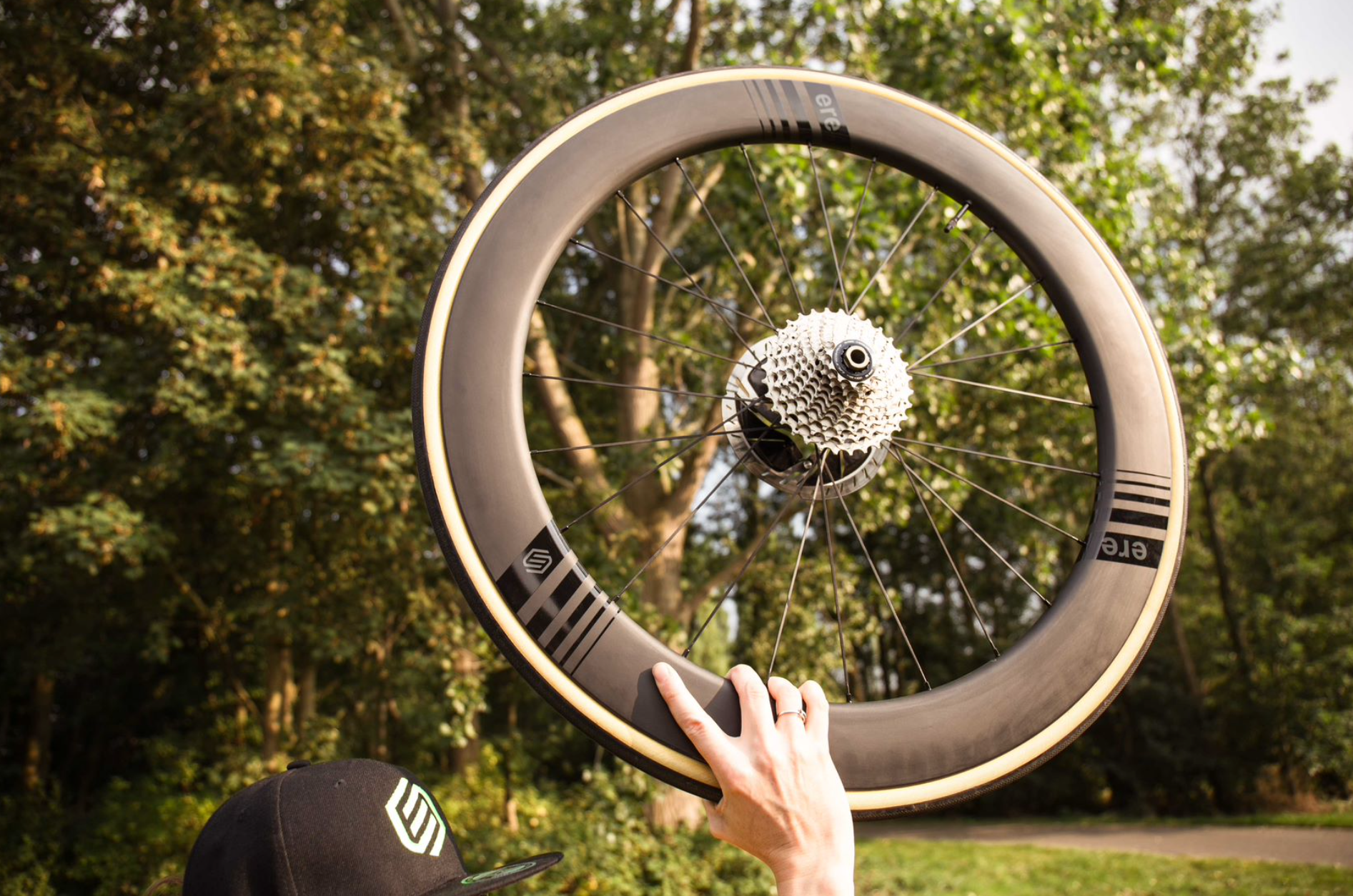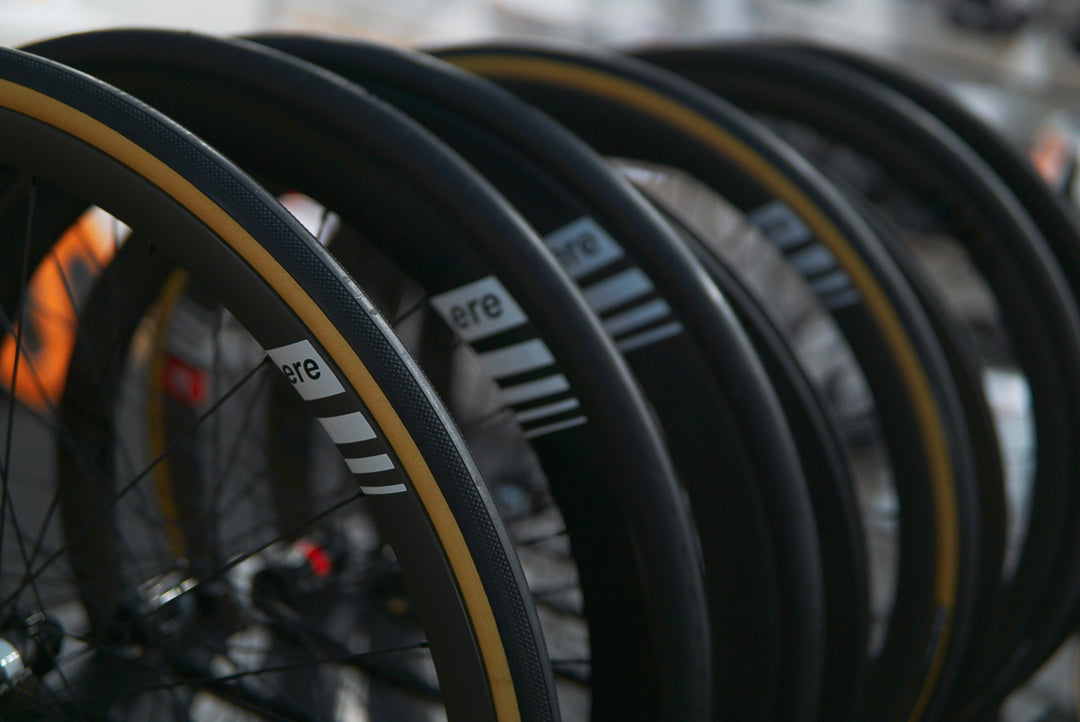WHEEL TECHNOLOGY

ere wheel technology
Innovative engineering
Product development is a process. The ere team carries a combined experience of over a century in bicycle product design and engineering.
There is something about wheels. Wheels have always intrigued us here et Ere. The beginning of Ere as a brand started with tyres. In our search for better tyres and more performance we discovered that the perfect fit for tubeless tyres on a rim did not exist. Enter Ere WHEELS.
When it comes to wheel technology, things can get complicated below is an outline of our ere wheel technology and how we build each different component of our wheels and what their specific attributes are.
We started out with a small development team to look into the dynamics of carbon performance wheels and before we knew it we were working with a large team to work on the development of a complete wheel line-up. We are super proud of our work and hope we can be a part of your success story. Happy Racing!
Ere hubs are available in different specification versions, following the technical positioning of our Genus, Omnia, Tenaci and Explorator wheels.
Let’s start with our Secure lock drive hubs, they are designed with a great attention to detail and a focus on engineering the most effective hub design; first there are the tight “tapered fit” spoke holes to fit the spokes in a way that locks and secures them into position, this ensures tensile strength and secures the spoke in case of a failure, so the rider can come to a safe stop and get their wheels serviced.The our hubs come in three versions: Genus, Omnia & Explorator, the genus model is the lightest with a carbon hub body and alloy spoke flanges, and the Omnia and Explorator are both 100% aluminium made, all our hub are 24 holes.
All our hubs are setup with X12 axles and can be retrofitted with either X15 or a QR setup. Conversion kits are available.




To make SLD hubs run at an even lighter rolling resistance and more durable, special Japanese EZO ceramic bearings "CER" can be installed and retrofitted to all ere hubs. We also have the standard Japanese HQS bearings ready for replacement should your wheels need them.
Bearings need to be installed by your local wheel service specialist or you can contact our wheel service center to help you. You can contact them at wheels@ereresearch.com
For wheels, the right aerodynamic shape is key in order to achieve the lowest possible wind drag resistance combined with the highest possible stiffness.
Our experience in working with Formula One technology and its challenges to re-direct airflow, has given us the insight we need in order to tackle this successfully. We are confident in claiming that our wheel-rim-tire designs are close to the ideal aerodynamic shape, when it comes to being confronted with an ever-changing wind angles in performance bike use.
Advanced bead bed technology is an ere rime shape design for high pressure performance tires that focusses on keeping the tire in its place on the rim. The safety hook and bead bed design will “bed” the bead cord of the tire, and lets it stay in position on the rim which is excellent for tubeless tires.
ABB rims are tubeless ready rims that will fit tubeless tires. It will allow you to run lower tire pressure on bigger volume tires more easily without pinch burping of the tire. All our ABB rim designs have an inner rim measure of 19mm, this will allow the tire to be less stressed under lower pressure and allows for a better user experience.
Advanced linear pull technology is an ere rim design that focusses on the lower inner wall of the rim, called the nipple bed. Here the spoke nipples are seated in the rim and apply a tremendous amount of stress to the rim-wall. This stress is first transferred to the nipple bed of the rim, and then linear from spoke hole to hub spoke hole.
While tensioning and de-tensioning during wheel assembly the spoke forces are sometimes unequal to each other. This results in a variation of stress in the nipple bed. TheALP designhelps to balance that stress and build a more stable wheel, where spoke tensions in return will also will be more balanced.EreALPnipple bed design is an angled and reinforced part of this section or the rim. It is designed to withstand the spoke forces without effecting the overall weight of the rim or effecting the linear forces in the rim.
Advanced calculated lay-up process is our thorough way of using composites in the best possible way. You can use composites in many different ways, but in order to achieve the desired result a lot of calculating, field testing and laboratory testing is needed. At ere we combine our experience and available resources and try to think out of the box, in order to go where nobody has gone before.
Today ACLP is used in a variety of ere products, such as rims, hubs and saddles.

We use our own specification aero bladed Talon spokes made from the best quality Swedish steel, because we know what we need for our wheel builds. We specify our own spoke butting thicknesses and spoke lengths. We only use aero bladed spokes in all our wheels (except the AE00 aero disc wheel).
“TA 2.0/0.95”stands for “Talon aeroblade spoke2.0mm by 0,95mm” meaning this spoke is made flat for improving the aerodynamics of the wheel and lowering the drag resistance and has a thickness of 0.95mm and only weighs4.7 gram per spoke, these spokes are used in ourGenuswheel models (with the excepetion of the Genus AE00 model).
“TA 2.2/1.5”stands for “Talon aeroblade spoke2.2mm by 1.5mm”meaning this spoke is made flat for improving the aerodynamics of the wheel and lowering the drag resistance and has a thickness of 1.5mm and only weighs6.5 gram per spoke, these spokes are used in ourOmnia & Exploratorwheel models.
“DWN”stands for “Double works alloy nipple” meaning this lightweight alloy nipple is only0.4 gram per nippleand can be adjusted from the inside or outside of the rim, the outside is for smaller trueing adjustments, the inside would be used when more tension needs to be applied to the spoke. These nipples are used in ourGenus & Omnia wheel models.
“SWN”stands for “Single works alloy nipple” meaning this lightweight alloy nipple can be used for trueing adjustments from the outside of the rim and it only weighs0.3 gram per nipple. These nipples are used in our Explorator wheel models.
Ere spokes are pre wheel production batch tested for tensile strength so we can ensure our quality consistency is where we expect it to be, we use a spoke tensile strength testing device for this, such as shown in the below image.

